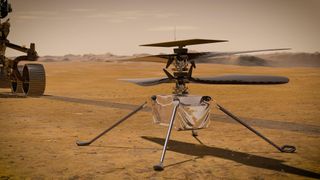The first helicopter on Mars phones home after Perseverance rover landing
The Ingenuity helicopter has reported in from the Red Planet.

The first helicopter ever sent to another world is doing just fine on Mars after surviving a "seven minutes of terror" landing aboard NASA's Perseverance.
The Ingenuity helicopter, which landed on Mars with Perseverance on Thursday (Feb. 18), is awake and communicating with controllers on Earth.
Controllers at NASA's Jet Propulsion Laboratory (JPL) received a downlink on Friday at 6:30 p.m. EST (2330 GMT) through the Mars Reconnaissance Orbiter, indicating the 4-lb. (2 kilograms) helicopter and its base station are both operating normally.
Related: The Ingenuity helicopter on Mars, here's what to know
Live updates: NASA's Perseverance Mars rover mission
Book of Mars: <a href="https://www.awin1.com/awclick.php?awinmid=2961&awinaffid=103504&clickref=hawk-custom-tracking&p=https%3A%2F%2Fwww.magazinesdirect.com%2Faz-magazines%2F6942884%2Fbook-of-mars-2nd-edition.thtml" data-link-merchant="magazinesdirect.com"" target="_blank">$22.99 at Magazines Direct
Within 148 pages, explore the mysteries of Mars. With the latest generation of rovers, landers and orbiters heading to the Red Planet, we're discovering even more of this world's secrets than ever before. Find out about its landscape and formation, discover the truth about water on Mars and the search for life, and explore the possibility that the fourth rock from the sun may one day be our next home.
"Both appear to be working great. With this positive report, we will move forward with tomorrow's charge of the helicopter's batteries," Tim Canham, Ingenuity Mars helicopter operations lead at JPL, said in a statement on Friday.
That power-up procedure, which occurred Saturday (Feb. 20), will charge the six lithium-ion "rotorcraft" batteries to roughly 30% of their planned capacity, and data will be sent back to Earth to decide how to proceed with future battery-charging sessions.
Amazing photo: Wow! See the Perseverance rover dangling above Mars
Get the Space.com Newsletter
Breaking space news, the latest updates on rocket launches, skywatching events and more!

For now, JPL plans to charge the batteries to 35% capacity in a few more days, and then to do weekly charging sessions to keep the helicopter warm on the cold Martian surface — and ready for its eventual flight in a few months.
Ingenuity is getting its power from Perseverance from the time being, but once the rover lets go of the helicopter, the drone will be charging fully on its own, using solar panels.
"After Perseverance deploys Ingenuity to the surface, the helicopter will then have a 30-Martian-day [31-Earth-day] experimental flight test window," JPL said in a statement. A Martian day or "sol" is 24 hours and 37 minutes, compared to Earth's 24 hours, and controllers are operating on Mars time for the first 90 sols of the mission.
"If Ingenuity survives its first bone-chilling Martian nights — where temperatures dip as low as minus 130 degrees Fahrenheit [minus 90 degrees Celsius] — the team will proceed with the first flight of an aircraft on another world," JPL added. "If Ingenuity succeeds in taking off and hovering during its first flight, over 90 percent of the project's goals will have been achieved. If the rotorcraft lands successfully and remains operable, up to four more flights could be attempted, each one building on the success of the last."
Ingenuity's flights could pioneer a new generation of soaring Mars explorers working either independently, or alongside far-future human landing missions. Flying drones on Mars could scout ahead of rovers to plan the best routes, or hover above dangerous terrain to perform scientific studies, among other applications.
Follow Elizabeth Howell on Twitter @howellspace. Follow us on Twitter @Spacedotcom and on Facebook.
Join our Space Forums to keep talking space on the latest missions, night sky and more! And if you have a news tip, correction or comment, let us know at: community@space.com.

Elizabeth Howell (she/her), Ph.D., is a staff writer in the spaceflight channel since 2022 covering diversity, education and gaming as well. She was contributing writer for Space.com for 10 years before joining full-time. Elizabeth's reporting includes multiple exclusives with the White House and Office of the Vice-President of the United States, an exclusive conversation with aspiring space tourist (and NSYNC bassist) Lance Bass, speaking several times with the International Space Station, witnessing five human spaceflight launches on two continents, flying parabolic, working inside a spacesuit, and participating in a simulated Mars mission. Her latest book, "Why Am I Taller?", is co-written with astronaut Dave Williams. Elizabeth holds a Ph.D. and M.Sc. in Space Studies from the University of North Dakota, a Bachelor of Journalism from Canada's Carleton University and a Bachelor of History from Canada's Athabasca University. Elizabeth is also a post-secondary instructor in communications and science at several institutions since 2015; her experience includes developing and teaching an astronomy course at Canada's Algonquin College (with Indigenous content as well) to more than 1,000 students since 2020. Elizabeth first got interested in space after watching the movie Apollo 13 in 1996, and still wants to be an astronaut someday. Mastodon: https://qoto.org/@howellspace

